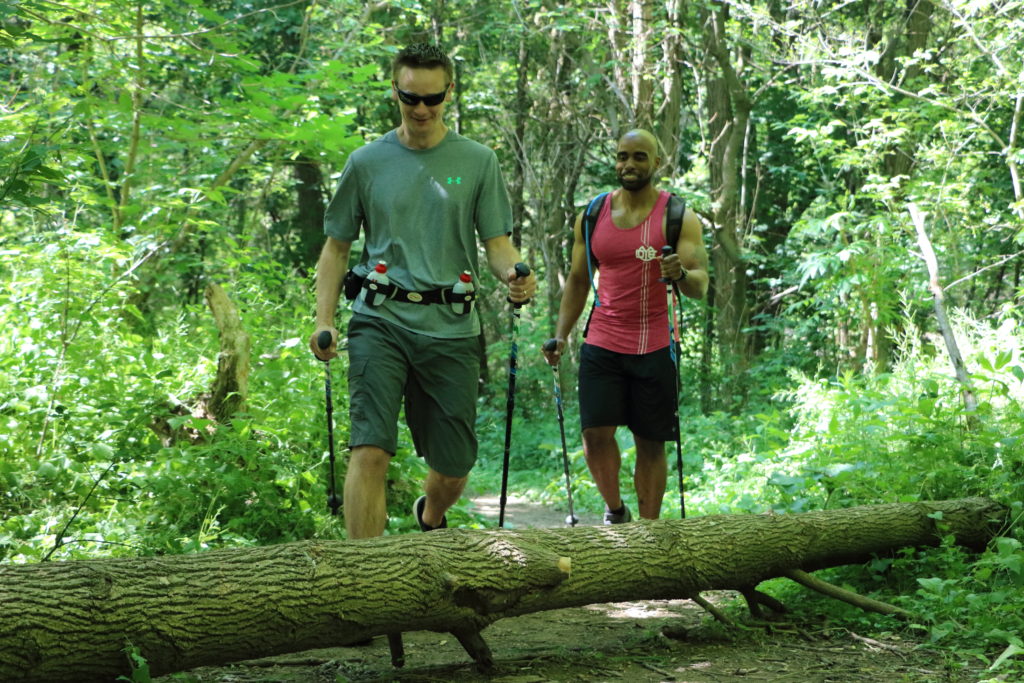Cross training is excellent for most athletes regardless of their sport and especially for runners.
It keeps your mind fresh while allowing your body to recover from the rigors of daily workouts.
In winter, some runners will weight train, snowshoe and swim to keep fit during running off days.
Now you can include Nordic Walking as a cross-training option to improve overall fitness.
An online article by Kraig Becker in Healthy Way titled, What Is Nordic Walking and Is It an Alternative to Running, takes a deeper dive into the activity.

Lisa Battista of Flint Design.
“If you’re looking to add a new element to your usual workout routine that doesn’t involve running, Nordic walking is an excellent alternative,” Becker says, adding, “Mixing in this type of exercise will increase your upper body strength, reduce your blood pressure, and build stronger lungs and heart.”
There are other health benefits to Nordic walking such as core strengthening, improving, assisting and promoting proper standing and walking posture, improved stability, balance, and increased the range of motion.
Fun fact: Did you know, there are approximately 10 million people worldwide who regularly Nordic walk. It is quickly spreading throughout Europe and North America.
Dr. Jack Taunton, former Chief Medical Officer for the Vancouver 2010 Winter Olympics and Paralympics Games and CMO for Canada at the Sydney Olympics has completed 62 marathons with a best performance of 2:25:29 and countless road races.
Dr. Taunton, who now Nordic walks said, “I use my Nordic poles for any walking I do because I lost balance sensation and power to my foot, ankle, quad, and hip flexors. I do long walks for training every day. Longest is four hours on weekends and alternate two and half hours faster and three hours at a moderate pace. Attack the hills and twice a week now, can do hill repeats – wear a heart rate monitor.”

You could say Nordic Walking has been a Godsend to Dr. Taunton, who has endured seven major spine surgeries since 2010.
He said: “I can stay fit. Thirty percent more energy output using your arms with the poles and you are upright in a biomechanical better position to walkers or crutches.”
Amy Ku, an avid runner since 2009 shares her passion for this type of workout.
She says, “I started pole walking in 2014. I had developed a heart issue and running was not recommended. I was lucky that one member of the (running store run club), Al, was a pole walker. So I asked him to teach me to walk with proper form. I also took training so I can practice on my own. I completed two half-marathons using poles. In 2017, I started running once again. I now alternate running with pole walking workouts regularly. Pole walking makes for great cross training as it provides a full body workout.”
For Ku walking with poles has given her great arm and core strength.
She says, “Walking with poles engages 95 percent of your body muscles which makes for a much more balanced workout than just walking alone or running.”
For those who want to start Nordic walking, she shared her tips:
1. Invest in a good pair of poles for optimum comfort and durability.
2. Find someone experienced to teach you how to walk with poles, and the proper forms. Technique is important in order to maximize the benefits.
3. Walk with a group helps to build confidence and makes long walks feel effortless.
4. Walk regularly and practice your techniques. It may feel awkward at first, but it won’t take long before it becomes second nature.
5. You don’t have to be in a race to walk. Train for your health!
If you love walking and looking for a new cross-training activity, then why not try Nordic walking?
What better time to start with February being Heart Month.
www.runwihttp://www.runwithit.cathit.ca
Twitter: @christineruns
Instagram: runwithit_christhttps://www.instagram.com/runwithit_christineblanchette/?hl=enineblanchette
Run With It on YouTube – runwithit








